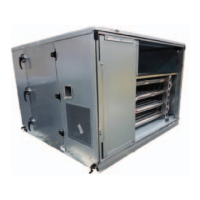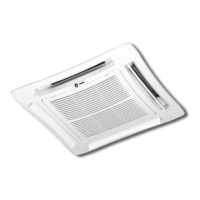Installation - Mechanical
CLCH-SVX07K-EN 29
Removing the Shipping Skid
Remove the wooden shipping blocks, wooden toe cleat if
there is one, and end cleats prior to lowering unit into final
position or installing the unit to the roof curb.
Ceiling Suspension
Note: Ceiling suspension is not recommended for units
larger than size 57 unless using a field-provided
mounting frame.
Using a Field-Provided Mounting Frame
If a field-provided mounting frame is used for ceiling
suspension, the installer/contractor must provide a
ceiling-suspended mounting frame designed to support
the length, width, and weight of the entire air-handling
unit. See “Dimensions and Weights,” p. 11 for approximate
weights.
Note: It is the building engineer’s responsibility to size the
structural channels and to provide the appropriate
hangers.
Structural channels in a field-provided frame can be
mounted parallel to airflow or perpendicular to airflow:
• For parallel-to-airflow channels, size channels based
on a four-point load distribution (see Figure 24.
• For perpendicular-to-airflow channels, size channels
based on the load distribution of the individual
sections and install the channels so that both ends of
every section are supported (see Figure 25).
Using Integral Base Frame
If using the factory-provided integral base frame for ceiling
suspension, individual sections and/or subassemblies will
have base frame shipping splits and base frame lifting
lugs. When using the base frame for ceiling suspension:
• Suspend the unit (on both sides of the unit) at each
shipping split lug as well as the four corners of the unit
(see Figure 26). See Figure 15 and Figure 16 and
Table 9 on page 26 for lug hole sizes.
• Bolt shipping splits together.
The hanger rods must extend through the bottom of the
base lug. It is the building engineer’s responsibility to
provide the appropriate hangers.
Shipping Gussets
Prior to pulling the shipping splits together, the shipping
gussets (see Figure 27) should be removed to simplify
panel removal (except for hurricane units or units that
require OSHPD certification). If there is enough access
after joining the shipping splits, the gussets can be
WARNING
Risk of Unit Dropping!
Improper use of the mounting legs could result in unit
dropping and crushing technicians which could result in
death or serious injury, and equipment damage. Do not
use mounting legs for ceiling suspension, external
isolation, or unit support during module placement.
Mounting legs are designed only to secure the unit to
the floor, housekeeping pad, or platform.
Figure 24. Typical suspension method-parallel channels
Figure 25. Typical ceiling suspension-perpendicular
channels
Figure 26. Ceiling suspension for unit sizes 3-57
Hole diameter
is 0.625 inches

